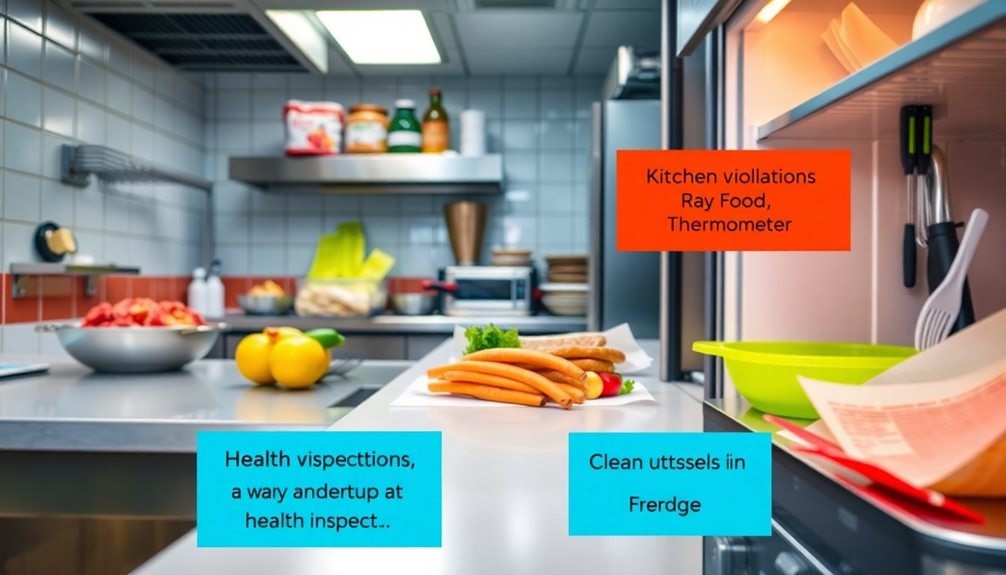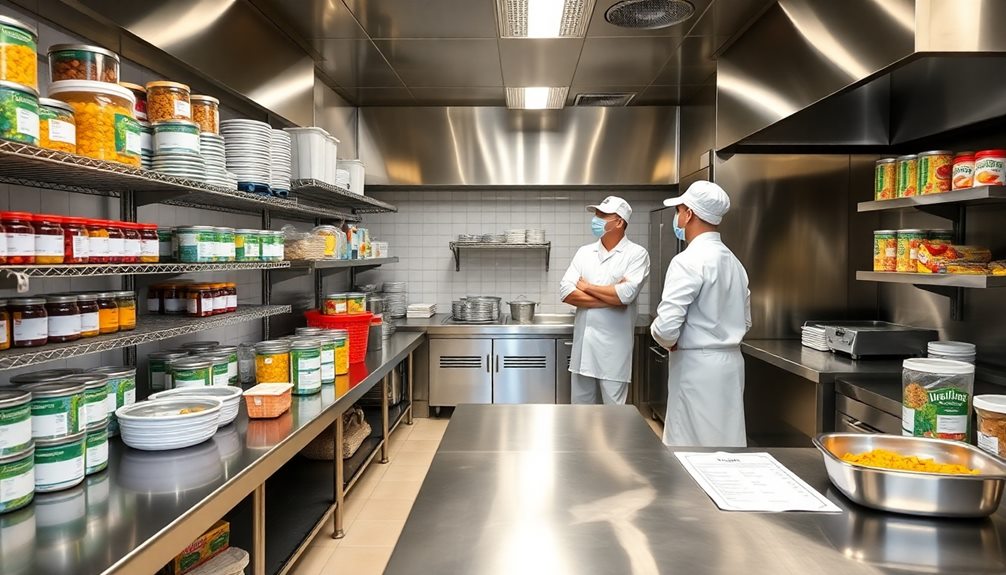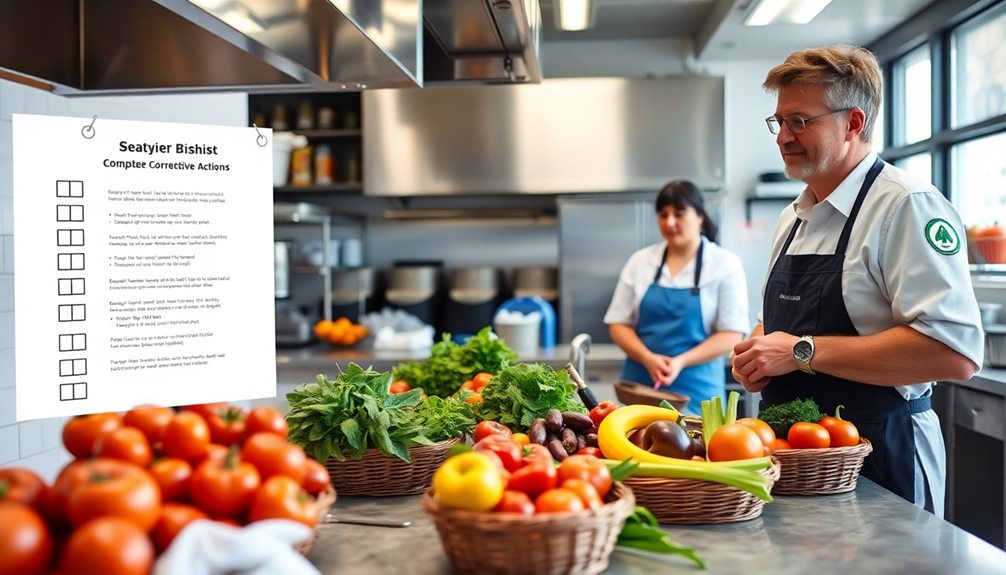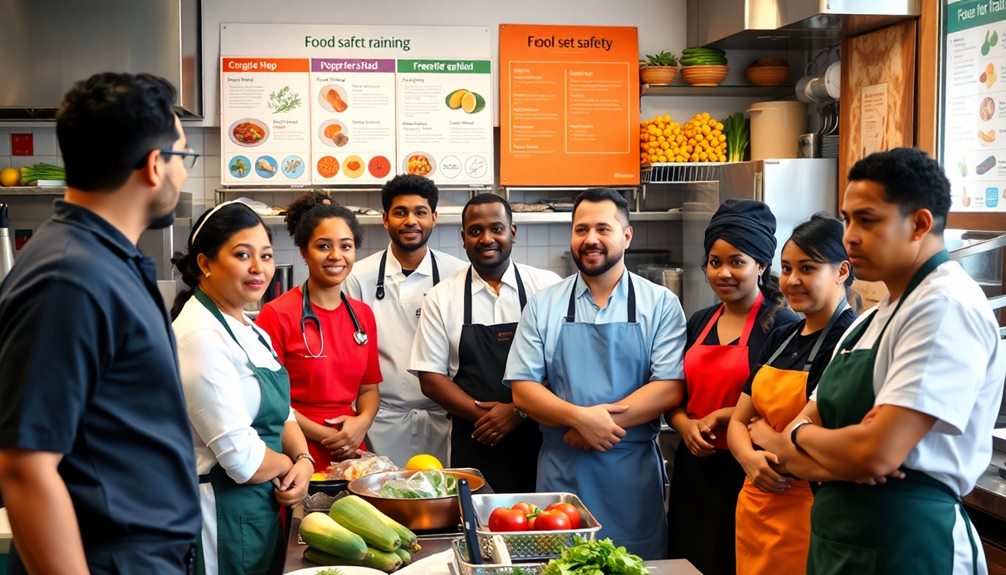To pass health inspections, you need to prepare thoroughly and stay proactive. Start by implementing a HACCP plan to identify potential hazards. Conduct regular self-inspections using checklists to guarantee cleanliness, proper food storage, and employee hygiene. Train your staff on safe food handling practices and make certain they understand the importance of handwashing. Focus on critical areas like temperature control and sanitation. Remember, health inspectors often visit unannounced, so stay vigilant. This way, you'll not only pass but set a standard in food safety. There's a lot more to this, so keep going to enhance your knowledge.
Key Takeaways
- Implement a HACCP plan to identify and mitigate food safety hazards effectively.
- Conduct regular self-inspections to ensure compliance with food storage and hygiene standards.
- Train staff thoroughly on proper food handling and sanitation practices.
- Maintain food temperatures: keep cold items below 4°C and hot items above 60°C.
- Address inspector feedback promptly and develop an action plan for any violations noted.
Preparing for Health Inspections

Preparing for health inspections is vital for guaranteeing your establishment meets safety standards and avoids costly violations. Start by implementing a Hazard Analysis Critical Control Point (HACCP) plan. This helps you systematically identify and mitigate potential hazards in food handling and preparation processes.
In addition, conduct regular self-inspections using checklists that cover significant areas such as food storage practices, cleanliness of your kitchen, and employee hygiene. This proactive approach guarantees compliance with food regulations and prepares you for the scrutiny of health inspectors.
Don't overlook the importance of food safety training. Train all staff on proper food handling and hygiene practices, emphasizing handwashing, equipment cleanliness, and preventing cross-contamination.
Keep your storage areas organized and labeled, ensuring food items sit at least 6 inches off the ground and that chemicals are stored separately from food products.
Common Health Code Violations

Understanding common health code violations is essential for maintaining food safety and avoiding penalties.
One of the most frequent issues involves improper food storage temperatures. Make certain cold items are kept below 4°C (40°F) and hot items above 60°C (140°F) to prevent bacterial growth. Additionally, cross-contamination can occur when raw foods, especially meats, are stored above ready-to-eat items, risking contamination from dripping juices.
Another critical violation is the lack of proper handwashing facilities or failing to use them correctly. Always wash your hands before handling food to minimize the spread of pathogens.
Inadequate sanitation practices can also undermine food safety. Regularly clean and sanitize food contact surfaces and utensils according to your cleaning schedules to avoid violations.
Key Areas of Focus

Consistently focusing on key areas during health inspections can make a significant difference in your establishment's compliance.
Prioritize food safety by ensuring food storage is at least 6 inches off the ground. This not only prevents contamination but also promotes proper air circulation.
Next, maintain food temperature control by keeping cold items below 4°C (40°F) and hot items above 60°C (140°F). This inhibits bacterial growth and is essential for compliance.
Implement proper handwashing techniques among your staff, making sure designated sinks are accessible.
Regular cleaning and sanitizing of food contact surfaces, utensils, and equipment is necessary for upholding hygiene standards and preventing cross-contamination.
Conducting Self-Inspections

To guarantee your establishment stays compliant, set up a regular self-assessment schedule.
Focus on key compliance areas like food storage, employee hygiene, and kitchen cleanliness.
Consider integrating a review of cold medications overview to guarantee staff are aware of potential health issues that could affect food safety.
This proactive approach not only helps you catch potential issues early but also reinforces a culture of safety among your staff.
Regular Self-Assessment Schedule
Conducting regular self-assessments is vital for maintaining health and safety standards in your establishment. Aim to perform self-inspections at least once a month using a thorough checklist that covers critical areas like food storage, temperature control, and employee hygiene practices. This proactive approach helps guarantee compliance with health codes and reduces the risk of violations.
Additionally, just as wood stove safety requires adherence to regulations, incorporating regular safety training for your staff can enhance their awareness of potential hazards, such as fire risks and proper emergency responses, which are essential for maintaining a safe environment wood stove safety standards.
Incorporate random self-inspections to mimic the unpredictability of official health inspections. This keeps your staff prepared and vigilant. Use temperature logs to monitor food storage, confirming cold items are below 4°C (40°F) and hot items above 60°C (140°F).
Regularly review cleaning schedules to verify that all food contact surfaces, utensils, and equipment are thoroughly cleaned and sanitized daily, preventing contamination.
Encourage staff involvement by providing training sessions on health codes and the importance of hazard identification in their work areas. When your team is engaged and knowledgeable, they're more likely to contribute to maintaining high standards.
Key Compliance Areas
Regularly focusing on key compliance areas during self-inspections is vital for guaranteeing food safety and health standards in your establishment.
By conducting thorough checks, you can identify potential issues before health inspections take place, helping you maintain compliance and avoid penalties. Additionally, confirming that your air quality is ideal can contribute to a healthier environment for both staff and customers, as seen in practices like air quality maintenance.
Here are five important areas to monitor during your self-inspections:
- Food Storage: Verify food is stored at least 6 inches off the ground and that raw meat is never above ready-to-eat foods to prevent cross-contamination.
- Employee Hygiene: Regularly assess employee practices to assure proper handwashing and appropriate attire.
- Cleanliness: Keep all food contact surfaces clean and sanitized to eliminate potential hazards.
- Temperature Control: Monitor food temperatures, keeping cold items below 4°C (40°F) and hot foods above 60°C (140°F).
- Food Preparation: Regularly review procedures to confirm safe food handling practices are followed.
Implementing a training program for your staff is significant, as it reinforces the importance of food safety and compliance during health inspections.
What to Expect During Inspections

During a health inspection, you can expect an unannounced visit from an inspector who'll evaluate your establishment's compliance with various food safety standards. Typically occurring 1 to 4 times a year, these inspections focus on aspects like employee hygiene, cleanliness of food preparation areas, and food storage practices. Your compliance history may influence how often inspectors visit.
Inspectors will assess whether you adhere to temperature control protocols and examine the overall cleanliness of your establishment. They'll categorize any violations as critical or non-critical, which can impact your score and lead to fines or even temporary closure for significant infractions.
It's vital to be prepared, as serious violations can jeopardize your business. After the inspection, the inspector will provide a report detailing their findings. You'll need to sign this report to acknowledge receipt, though it doesn't mean you agree with the reported violations.
Understanding local health department regulations and food safety laws is important for your staff to guarantee compliance and maintain a safe environment. Being proactive in these areas can help you pass health inspections with confidence.
Responding to Inspector Feedback

Responding to inspector feedback can feel overwhelming, but it's vital for maintaining your establishment's compliance and reputation. To effectively manage this process, consider the following steps:
- Acknowledge the inspector's observations: This shows respect for their expertise.
- Ask for clarification: If there are unclear violations, don't hesitate to seek clarification to guarantee you understand the required corrections.
- Take detailed notes: Document the inspector's comments and recommendations for future reference and training.
- Implement corrective measures: Promptly address any violations noted during the health inspection, and maintain records of these actions to demonstrate compliance.
- Schedule a follow-up meeting: Discuss the inspector's feedback with your staff and reinforce training on food safety protocols to prevent future violations.
If disagreements arise about any violations, respectfully request a review or clarification from the inspector.
If justified, consider formally appealing the decision.
Understanding Inspection Scores

Understanding your health inspection scores is key to maintaining compliance and improving your establishment. These scores, typically ranging from 0 to 100, reflect your adherence to food safety protocols. Violations are categorized as critical or non-critical, with critical violations posing a higher risk to food safety and leading to more significant point deductions. Knowing the scoring systems in your area can help you strategize better.
| Violation Type | Impact on Score |
|---|---|
| Critical Violations | Major point deduction |
| Non-Critical Violations | Minor point deduction |
Familiarizing yourself with common violations helps identify areas for improvement. Regular self-assessments and training guarantee your staff understands food safety regulations and best practices. This proactive approach not only boosts your health inspection scores but also promotes a culture of compliance within your establishment. Aim to create a routine for monitoring adherence to food safety protocols, as consistent efforts will lead to better outcomes during inspections. Remember, higher scores reflect your commitment to food safety and enhance your establishment's reputation.
Corrective Actions Post-Inspection

What steps should you take after receiving an inspection report? It's essential to act swiftly and effectively to address any violations noted. Start by developing a detailed plan for corrective actions and guarantee compliance with health regulations.
Consider these key steps:
- Review Violations: Go through each violation listed in the report and prioritize them based on severity.
- Implement Corrective Actions: Outline specific measures you'll take to address each issue and establish a timeline for completion.
- Engage Staff Training: Train your staff on the violations to reinforce the importance of compliance and proper food safety practices.
- Document Everything: Keep thorough documentation of your corrective measures, including dates, actions taken, and staff involved.
- Schedule Follow-Up Inspections: Arrange for follow-up inspections within 5 to 45 days to demonstrate your commitment to ongoing adherence to health standards.
Training Staff on Food Safety

Effective training on food safety is essential for maintaining compliance and ensuring the health of your customers. Start by implementing regular staff training sessions that focus on fundamental food safety practices, including proper handwashing techniques. This minimizes the risk of contamination during food preparation.
Make sure every employee obtains a valid Food Handlers Permit, showcasing their grasp of significant food safety principles and regulations. Conduct periodic refresher courses to keep your team updated on the latest best practices and any regulatory changes related to food handling.
Utilize checklists and training materials that underscore critical food safety standards, such as temperature control and preventing cross-contamination. Ensuring all staff have access to these resources is key.
Fostering a culture of accountability is important. Assign food safety champions within your team to monitor compliance and provide guidance on maintaining high hygiene standards in the kitchen.
This not only reinforces the importance of food safety but also empowers staff to take ownership of their roles in keeping your establishment safe. By prioritizing food safety training, you'll create a healthier environment for both your customers and your staff.
Maintaining Compliance and Records

To keep your establishment ready for health inspections, it's crucial to maintain organized compliance records.
Having accurate documentation not only demonstrates your commitment to food safety but also prepares you for any inspections that may arise.
Here are key areas to focus on:
- Health inspection records: Track dates, scores, and any corrective actions taken.
- Employee certifications: Confirm staff have up-to-date Food Handler and Manager Certifications.
- Document cleaning schedules: Keep maintenance logs for all equipment and food contact surfaces.
- Temperature logs: Accurately record temperatures for food storage and preparation areas.
- HACCP plan updates: Regularly review and adjust your HACCP plan, documenting changes and staff training.
Frequently Asked Questions
How Often Does a Health Inspector Come Around to Conduct a Health Inspection?
Health inspectors typically visit your establishment 1 to 4 times a year, depending on local regulations and your inspection history. You might see them more often if you've had previous violations or customer complaints.
Who Should Walk Around With a Health Inspector During an Inspection?
You should have a knowledgeable staff member or yourself accompany the health inspector during the inspection. This person needs to understand food safety practices, HACCP plans, and be ready to address questions and concerns.
How Often Are Health Inspections Performed in Tennessee?
In Tennessee, health inspections dance through food establishments at least twice a year. If risks loom large, expect them more often. High-risk venues might see inspectors up to four times, ensuring safety remains a priority.
What Is a Point of Focus During Health Inspections on Quizlet?
During health inspections, you should focus on proper food storage practices. Guarantee food's stored correctly, keeping raw items below ready-to-eat ones, and maintain cleanliness in preparation areas to prevent contamination and guarantee safety.
Conclusion
Passing health inspections isn't just about checking boxes; it's about creating a culture of safety and care in your establishment. When you prioritize food safety and hygiene, you're not only protecting your customers but also your reputation and business longevity. Remember, consistent self-inspections and staff training can greatly reduce the risk of violations. Embrace these practices, and you'll find that health inspections can become an opportunity for improvement rather than an intimidating challenge.









